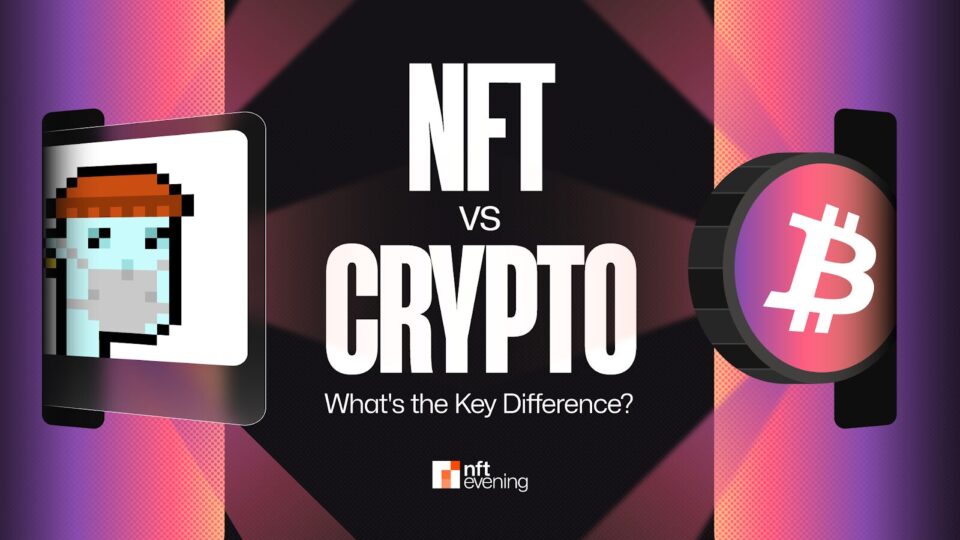NFTs and cryptocurrencies are two of the most talked-about digital assets today. Both are based on blockchain technology, but they serve very different purposes.
In 2024, the global cryptocurrency market reached a value of over $3.21 trillion, while NFT sales exceeded $67 billion. These numbers show how popular both have become, but understanding their differences is key to using them wisely. In this guide, you will learn the key differences between NFT vs crypto and how they work.
Key Takeaways:
- An NFT, or Non-Fungible Token, is a digital asset stored on a blockchain that proves someone owns a unique item, such as digital art, music, or virtual collectibles, and it cannot be copied or replaced.
- Cryptocurrency is virtual money that uses cryptography for secure transactions, operates on decentralized networks, and can be used for payments, investments, or transferring value without the need for banks.
- NFTs are different from crypto in terms of fungibility, as NFTs are unique and can’t be replaced or traded one-to-one, while cryptocurrencies like Bitcoin are fungible, meaning each unit is identical and interchangeable.
What is an NFT?
NFTs or Non-Fungible Tokens can be seen as virtual assets or collectibles in that they are unique digital items. If you own an NFT, you can be assured only one such original item exists. They are used to digitize all kinds of files from art to music, videos, or even in-game content.
Today, after selling an NFT, it’s possible to “prove” who the current owner is, because that information is stored on blockchain. It allows for “recording” the ownership using a token on the Ethereum blockchain for example. Once the ownership record is established on the blockchain, no one can go back and change it. This is also the reason for the worth of the NFT due to the honesty factor it provides.
For instance, many NFTs are sold for personal satisfaction or decoration purposes, while others are used to obtain some benefits or rewards. There are those who view them as an asset class as well – an investment opportunity of sorts. For instance, back in 2021, Beeple’s NFT “Everydays: The first 5000 days” sold for $69 million.
Read our detailed guide on what is an NFT and how it works.
What is Cryptocurrency?
Cryptocurrency, or crypto, is digital money. It doesn’t exist in physical asset form and isn’t controlled by banks or governments. Instead, cryptocurrencies run on blockchains, where all transactions are recorded publicly. This makes them secure, fast, and decentralized.
The most popular cryptos are Bitcoin and Ethereum, but there are thousands of others, each with its purpose. For example, Bitcoin is mostly used as digital gold for saving value, while Ethereum also supports smart contracts, enabling applications like NFTs.
Crypto works by using cryptography to secure transactions. This means people can send or receive money without relying on a middleman, like a bank. Transactions are verified by miners or validators on the blockchain.
Hence, both NFTs and crypto are blockchain-based, but they serve different purposes. NFTs prove ownership of unique items, while crypto is mainly used for buying, saving, or trading value.
NFT vs Crypto: Similarities
NFTs and cryptocurrencies are both digital assets, not physical assets, that rely on the same technology – blockchain. They have some key similarities because of how they are created and managed:
Blockchain Technology
Blockchain technology is like the backbone for both NFTs and crypto. A blockchain is a type of digital ledger, or a database, where all transactions are recorded.
This system is public and secure, so anyone can check the records, but no one can change them. NFTs and cryptocurrencies both use this technology to keep track of ownership.
For example, Ethereum is one popular blockchain that supports both crypto (like Ether) and NFTs.
Decentralization
Another similarity is decentralization. Neither NFTs nor crypto are controlled by banks, governments, or any single organization. Instead, they are managed by a network of computers around the world.
This means you can trade or own virtual assets without needing approval from a middleman. For example, if you buy BTC, it goes straight to your digital crypto wallet, and no one can take it away unless you lose your private keys.
Scarcity
Lastly, both have value because of scarcity. Cryptocurrencies like Bitcoin have a limited supply – only 21 million Bitcoins will ever exist.



